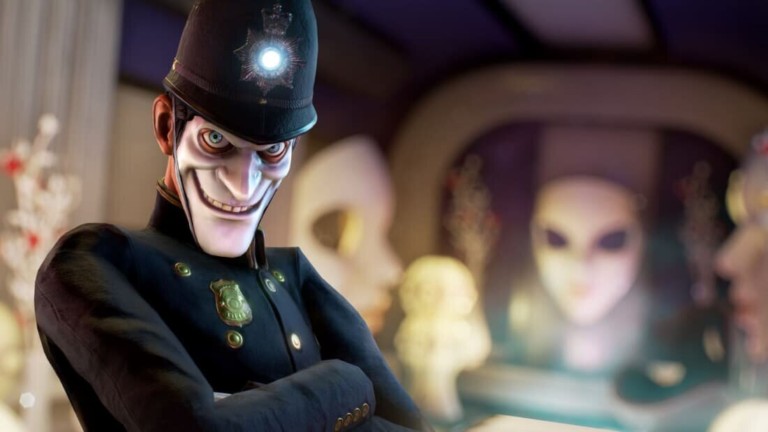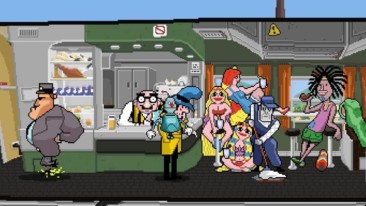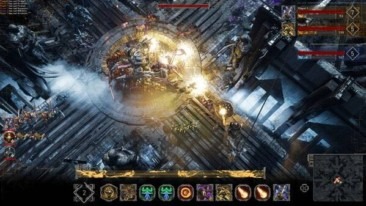We Happy Few by Compulsion Games
Set in a place called Wellington Wells, We Happy Few unfolds in an alternate history surrounding World War II where everyone is encouraged to take a pill called Joy – a hallucinogenic drug that makes users docile while also altering their world to seem happy and bright.
People off the Joy drug are vilified and sent to live in squalor outside fancy districts until they decide to take Joy again. Throughout the 25-hour-or-so campaign, you’ll play the game experience through the eyes of three different protagonists: Arthur, a man haunted by a past involving his younger brother; Sally, a mother who is also a chemist drug dealer; and Ollie, a former soldier coping with the loss of a deceased loved one.
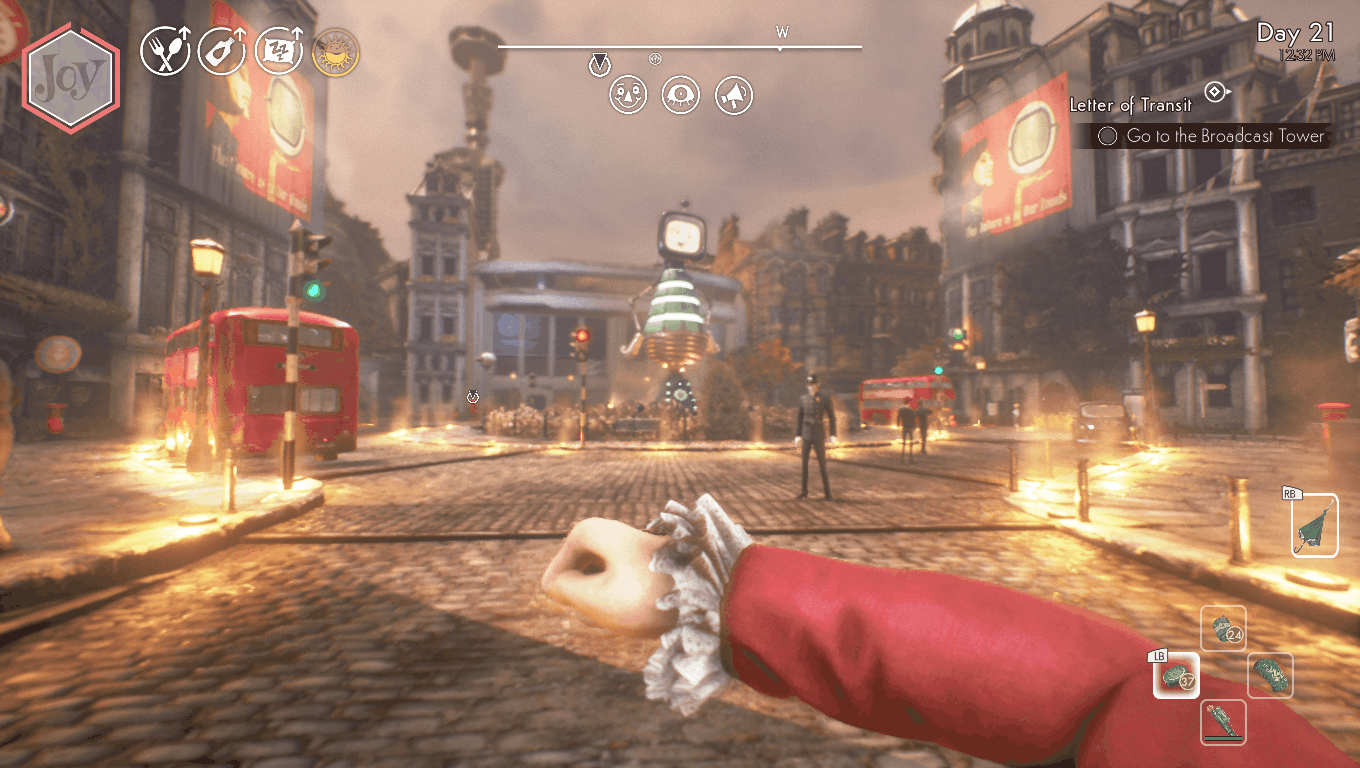
The gameplay feels akin to a smaller version of a Bethesda-era Fallout with survival elements. Parts of the world map are even randomly generated to make subsequent play-throughs different. The goal is to progress the narrative by taking on the various quests throughout while also scavenging items for basic survival.
You have hunger, thirst and sleep meters to manage. Thankfully, these aren’t as nagging as they are in something like The Sims, but more of an aside to pay attention to or suffer detrimental passive effects. For those who are not a fan of these types of survival mechanics, they can be adjusted when you start a new game.
Smile, Borrow, Steal
We Happy Few is an exploration-heavy, open-world experience where you have to loot, sneak and fight to survive. The world contains big open spaces filled with useful crafting ingredients, houses you can explore for all your looting needs, and shops where you can transact. The game also has some fast-travel spaces you can utilize to hop around the map or when you want to sleep and progress the game clock.
The map feels huge and has a lot of areas to explore. I had fun exploring the many districts in the game in my quest to loot every useful item I could find; it was rewarding to see and explore the game’s unique setting.
Everything from the music to the game’s visual art style makes the setting feel rich and different: the original soundtrack contains a fantastic selection of songs that feel like they were pulled out of an older era and fit nicely with the game. The game looks great, with finely detailed textures and environments while maintaining a stable frame rate.
But at a glance I can see how some may think it doesn’t look as good as other modern first-person games; I did encounter a couple of visual bugs, from characters being stuck in geometry to characters randomly warping around. These instances only happened a couple of times and – oddly – mainly during the first couple of hours of the game. It was all visual bugs and nothing necessarily game-breaking.
Shiny Happy People
I’ve played many games in my day, and I cannot stress enough how unique this game’s world feels. It’s inspired by dystopian novels and movies like A Clockwork Orange, but feels unique. One aspect of the game I really appreciated was its use of environmental storytelling. Much like instances in Bioshock and the modern Fallout games, examining the environment may reveal things. Notes scattered about houses, posters plastered onto walls, eavesdropping on conversations,,,it all adds to the game’s rich narrative setting. There is so much attention to detail that makes the world feel more realized and intriguing.
One house I was looting had an old man named Thomas, sitting in a chair in a room upstairs with rotted food by his side. Downstairs featured a young couple with a casket in the living room with a sign reading “Bon Voyage Thomas.” Another house I entered had a bunch of notes posted around the house on the stove, fireplace and television set with reminders pertaining to each item. I was able to gather so much from mise-en-scene without needing character dialogue.
But some of the magic was lost when I encountered the same house with those posted notes in a different district in the game, so the world is not as polished or wholly unique as it could have been.
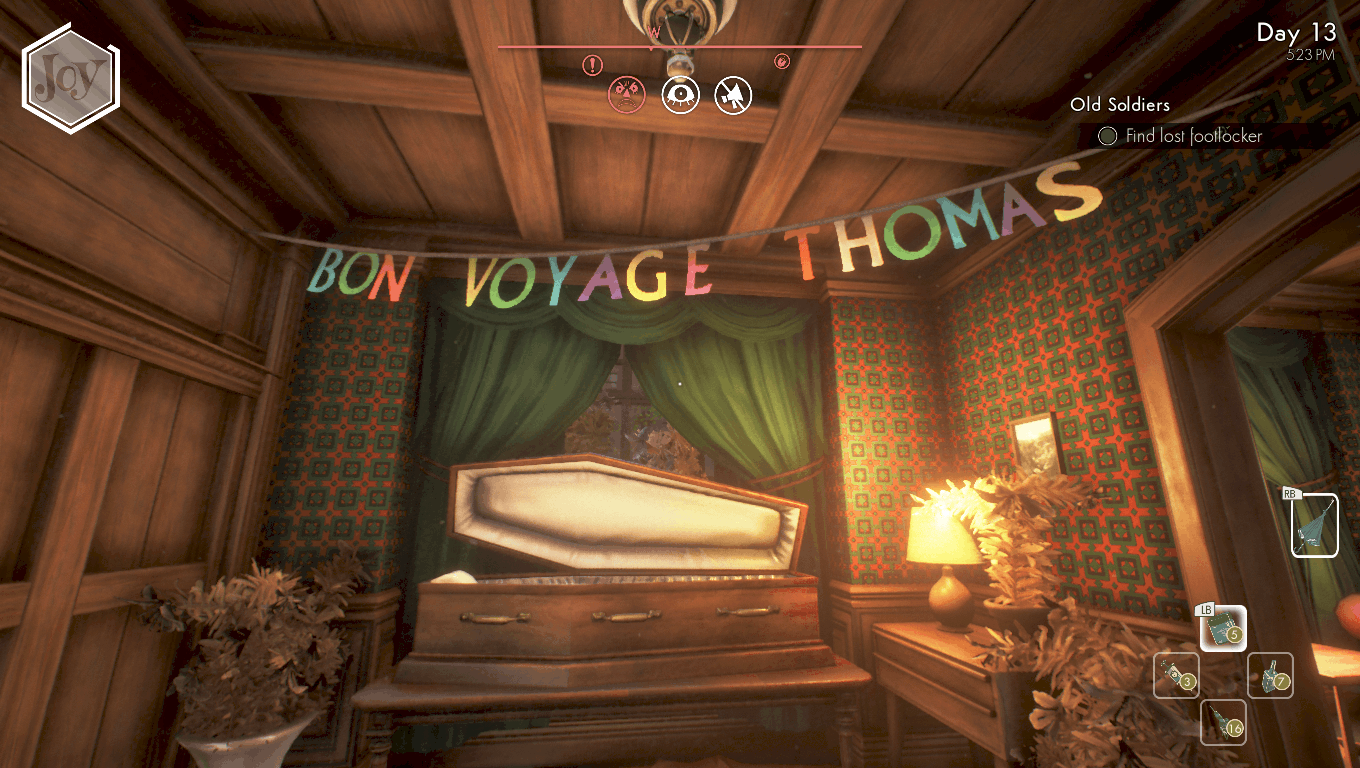
The Joy of Stealth
We Happy Few is strictly melee-focused when the combat gets going, but it’s also important to understand the game’s stealth mechanics in order to not be overwhelmed by enemies. You’ll have to utilize distracting items like throwable bottles to lure enemies toward a specific place.
Sneaking behind people allows you to perform a silent combat take-down, or you can crouch in tall grass or hide in spaces to avoid and methodically take down enemies. Don’t expect fantastic A.I. in these encounters; it all feels very video game-y, where enemies will forget about you completely when you are out of sight. This lead to me cheesing a lot of the stealth in this game. I’d throw glass bottles to a specific corner and take down enemies one by one with ease.
Knowing when to be stealthy and when to utilize melee combat is essential for survival, especially when you have to take things like weapon degradation and resource management into account. I felt the game – on the Normal difficulty setting – was balanced enough to the point where stealth and combat was enjoyable. Both are not necessarily as polished as they could be, but I felt they were enjoyable enough.
Happy and Crafty
There are plenty items you can use in crafting weapons, healing, bombs, and even gadgets that help with sneaking. There are a wide variety of things to craft, and I’d say it’s an essential component to making it through the game. Thankfully, there were no shortage of items to loot, which helped to open up crafting options. I mainly focused on crafting a fake Joy pill to fool people into thinking I was taking my required doses and healing items because often my attempts at sneaking would fail and lead to combat encounters.
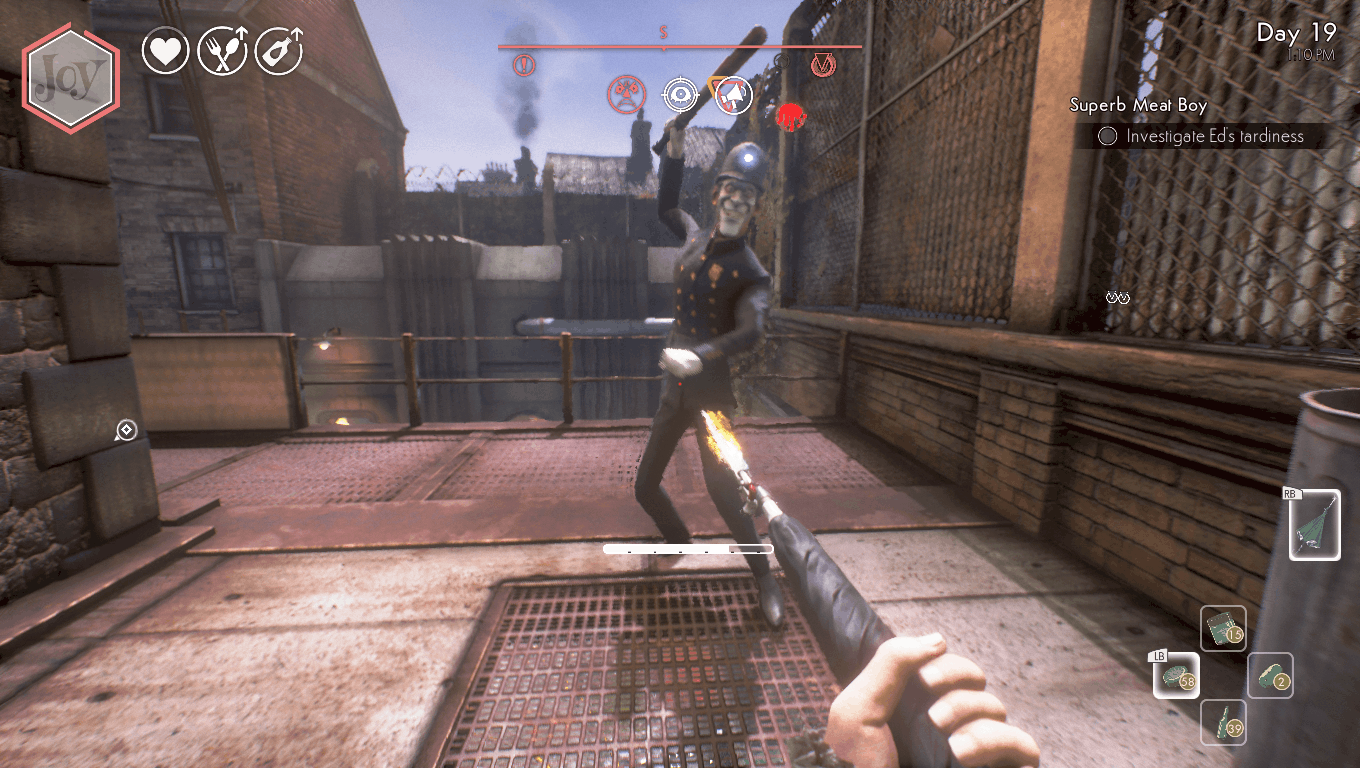
Each character plays differently, each with their own strengths and weaknesses: Arthur was a more all-around character, while Sally offered a more stealth-heavy experience. Sally is more fragile than the other two protagonists, but she can craft an array of useful chemicals she can use to her disposal. Ollie, on the other hand, is more combat-focused with no emphasis on stealth. Playing as other characters will challenge you to relearn and adjust your play style accordingly.
In a way I wish you could choose to play as a certain characters at the start of a new game, because I had more fun using light stealth instead of it being my main play style.
A Skill-Testing Question
Each character also has their own skill tree, and if you focus skill points towards certain play styles, it can make situations less satisfying. For example, in Arthur’s skill tree, one upgrade allows you to hold the attack button for a stronger attack. Since I found the combat and stealth to be not as polished as other first-person games, your experience may depend on where you decide to spend your skill points. The problem with having this customization is that if you decide not to focus on other play styles, when certain situations in the game arise to change up your style, it may sully your experience. I think your experience will heavily be dictated by what skills you choose to acquire. Take, for example, an ability which I found was hugely useful:
In certain districts you make pedestrians and constables more suspicious if you run. One skill tree ability lets you run in these districts without raising suspicion. Walking in general is not slow, but running is essential to make for a more enjoyable experience because of how much ground you have to cover to complete quests and to just get around the map.
It also doesn’t help that skill points are only rewarded via completing side or main quests. In games like Fallout: New Vegas, you gain experience for exploration, skills and even crafting. It would make certain types of play styles more rewarding. Exploration-first players would feel more of a sense of progression alongside their hoarded items. I feel like it was a missed opportunity to make the game not rely so heavily on quests, but thankfully the quests were, for the most part, entertaining.
Everyone Has a Tale to Tell
The main narratives for each these characters were fun, and the side quests involved a nice array of NPCs, each with their own bite-sized stories. It also helps that the writing in this game is spot-on and the voice actors do a phenomenal job of selling their stories. The standard fare of helping people find a missing item or helping them with a not-so-difficult-task-style quests are here, but when they are set in a world as strange and unique as We Happy Few, it’s enough to make them feel fresh.
During one quest, I stumbled upon a cult of people who worship a sacred yam. Another quest had me infiltrate a popular musician’s house to steal his clothes and impersonate him just to get into a Simon Says club. The game is quirky and doesn’t take itself too seriously. It’s also well-developed and steeped with notes and interactions that flesh out the game’s fascinating setting.
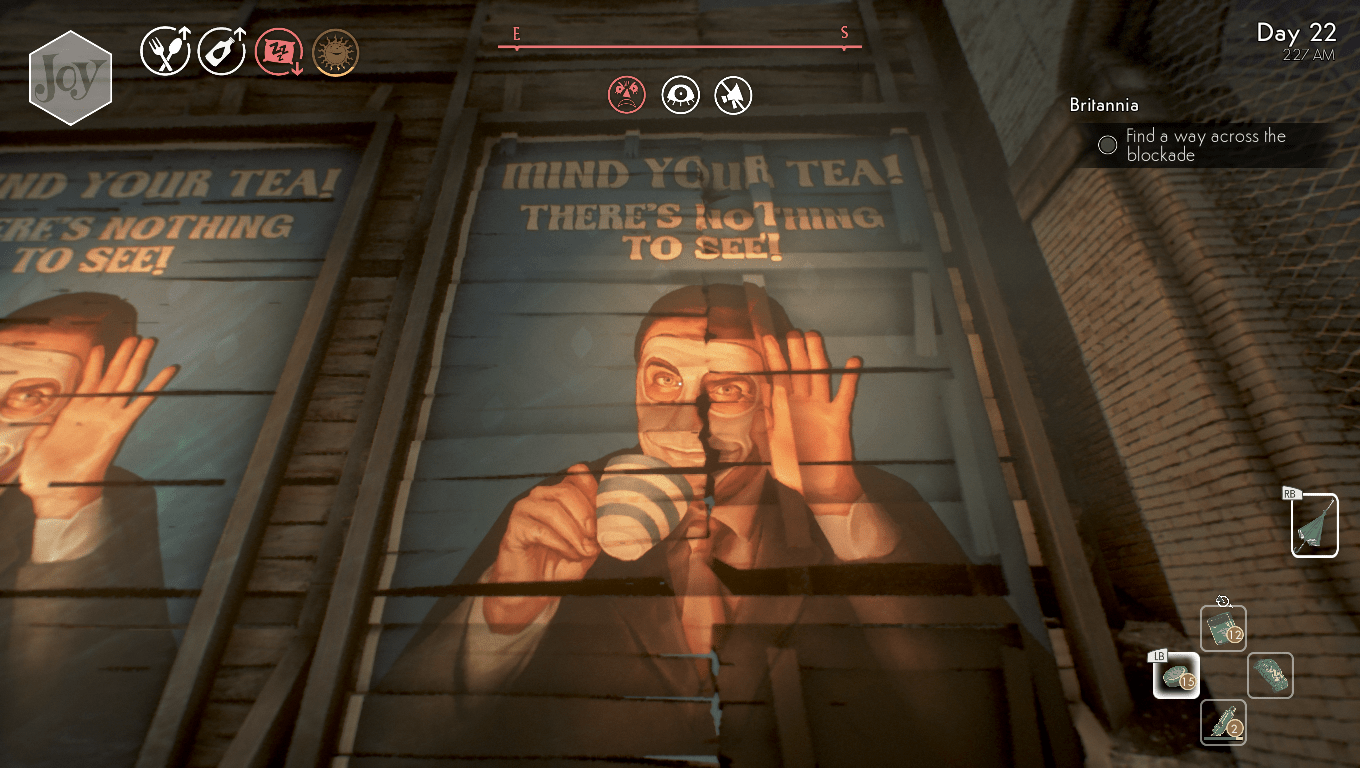
Come On, Get Happy
Many people may be turned off by this game at the start, and I found myself in a similar situation; there’s a learning curve that takes a good couple of hours to overcome. At the start of the game I felt the game was uninspired and lacking in many regards. The first area of the game puts you in an area with the downers. I wasn’t a big fan of these areas because I felt the architecture and quests were so bland that it made it tough to explore: houses looked the same and the few quests were bland.
It wasn’t until I entered a Joy-filled district that the game started to shine, and, at that point, I learned more about how to survive in this world and the different mechanics in the game. It definitely feels like the developers put a lot of work into certain areas of the game as opposed to others, which made the overall experience inconsistent.
We Happy Few is an ambitious game lacking polish in a number of areas – from its steep learning curve to its inconsistent world design, there are a number of things that could have used more work. I enjoyed many other aspects of the game, however, from its wonderfully unique setting to its well-realized protagonists. It’s unlike anything I’ve played before, and an open world survival experience I won’t soon forget.
We Happy Few is available via the Microsoft Store, Playstation Store and Steam.
Watch the trailer for We Happy Few below:

